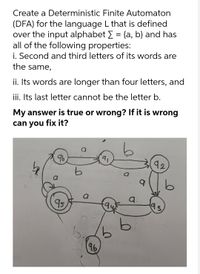
Computer Networking: A Top-Down Approach (7th Edition)
7th Edition
ISBN: 9780133594140
Author: James Kurose, Keith Ross
Publisher: PEARSON
expand_more
expand_more
format_list_bulleted
Question

Transcribed Image Text:Create a Deterministic Finite Automaton
(DFA) for the language L that is defined
over the input alphabet E = {a, b} and has
all of the following properties:
i. Second and third letters of its words are
the same,
ii. Its words are longer than four letters, and
iii. Its last letter cannot be the letter b.
My answer is true or wrong? If it is wrong
can you fix it?
96
91
92
a
a.
95
9.
96
Expert Solution
This question has been solved!
Explore an expertly crafted, step-by-step solution for a thorough understanding of key concepts.
Step by stepSolved in 2 steps with 1 images

Knowledge Booster
Similar questions
- Draw a deterministic finite automaton (DFA) that recognizes the language consisting of strings overthe alphabet {a,b} which contain either exactly two a's (which need not be consecutive) and anynumber of b's, or exactly two b's (which need not be consecutive) and any number of a's (and containsonly such strings.) Use JFLAP and submit the saved file.arrow_forwardCan you please help me with this question because I am struggling on how to answer this question, can you please do the turning machine with circles or drawing something that will help me understand ti visually. I put a photo for you to understand what I mean I need something like that to help me understand. Can you please help me with this question I need help with part B. question that I need help with:3.8 Give implementation-level descriptions of Turing machines that decide the following languages over the alphabet {0,1}. b. {w| w contains twice as many 0s as 1s}arrow_forwardCan you please help me with this problem because I don't understand how to do this problem. Can you please help me with this problem. Can you please explain this step by step.arrow_forward
- Let L1, L2, and L3 be languages over some alphabet. In each case below, two languages are given. Say what the relationship is between them. (Are they always equal? If not, is one always a subset of the other?) Give reasons for your answers, including counterexamples if appropriate. 1. L1(L20L3), L1L20LL3 2. LinL;, (L nL2)*arrow_forwarduse this link to simulate http:// automatonsimulator.com/arrow_forwardI keep getting the wrong answer can you please help me with this: Could you assist me with question 2.7 part C? I'm having difficulty with this problem and would greatly appreciate help in creating a state diagram for the push-down automaton in part C. question for 2.7 2.7 Give informal English descriptions of PDAs for the language. c. {w#x | w R is a substring of x for w, x ∈ {0,1} ∗ }arrow_forward
- Consider the language L of strings over the alphabet Σ = {a, b} which contain an equal number of a’s and b’s, and the set of b’s is consecutive in the string, e.g., ab, abba, aabb, abbbaa, aaabbbbbaa, etc. Note that ε ∈ L for completeness (0 number of a’s is equal to 0 number of b’s, which are also consecutive). Show that this language is context-free by giving a context-free grammar. Please make sure to test the answers onhttps://web.stanford.edu/class/archive/cs/cs103/cs103.1156/tools/cfg/arrow_forwardConstruct a CFG and PDA for the language B={w| w is a string over {a,b} with the same count of a's and b's}. For example, abba € B, abab e B,aabb € B, babbbaaaba € B, that is, there is no particular order in which a's and b's appear in w as long as there is the same amount of them.arrow_forwardConstruct a PDA that matches all strings in the language over {x,y} such that each string has an odd length and its middle symbol is 'x'. Editor Below, give a short description of the set of strings associated with each state of your PDA.arrow_forward
arrow_back_ios
arrow_forward_ios
Recommended textbooks for you
 Computer Networking: A Top-Down Approach (7th Edi...Computer EngineeringISBN:9780133594140Author:James Kurose, Keith RossPublisher:PEARSON
Computer Networking: A Top-Down Approach (7th Edi...Computer EngineeringISBN:9780133594140Author:James Kurose, Keith RossPublisher:PEARSON Computer Organization and Design MIPS Edition, Fi...Computer EngineeringISBN:9780124077263Author:David A. Patterson, John L. HennessyPublisher:Elsevier Science
Computer Organization and Design MIPS Edition, Fi...Computer EngineeringISBN:9780124077263Author:David A. Patterson, John L. HennessyPublisher:Elsevier Science Network+ Guide to Networks (MindTap Course List)Computer EngineeringISBN:9781337569330Author:Jill West, Tamara Dean, Jean AndrewsPublisher:Cengage Learning
Network+ Guide to Networks (MindTap Course List)Computer EngineeringISBN:9781337569330Author:Jill West, Tamara Dean, Jean AndrewsPublisher:Cengage Learning Concepts of Database ManagementComputer EngineeringISBN:9781337093422Author:Joy L. Starks, Philip J. Pratt, Mary Z. LastPublisher:Cengage Learning
Concepts of Database ManagementComputer EngineeringISBN:9781337093422Author:Joy L. Starks, Philip J. Pratt, Mary Z. LastPublisher:Cengage Learning Prelude to ProgrammingComputer EngineeringISBN:9780133750423Author:VENIT, StewartPublisher:Pearson Education
Prelude to ProgrammingComputer EngineeringISBN:9780133750423Author:VENIT, StewartPublisher:Pearson Education Sc Business Data Communications and Networking, T...Computer EngineeringISBN:9781119368830Author:FITZGERALDPublisher:WILEY
Sc Business Data Communications and Networking, T...Computer EngineeringISBN:9781119368830Author:FITZGERALDPublisher:WILEY

Computer Networking: A Top-Down Approach (7th Edi...
Computer Engineering
ISBN:9780133594140
Author:James Kurose, Keith Ross
Publisher:PEARSON

Computer Organization and Design MIPS Edition, Fi...
Computer Engineering
ISBN:9780124077263
Author:David A. Patterson, John L. Hennessy
Publisher:Elsevier Science

Network+ Guide to Networks (MindTap Course List)
Computer Engineering
ISBN:9781337569330
Author:Jill West, Tamara Dean, Jean Andrews
Publisher:Cengage Learning

Concepts of Database Management
Computer Engineering
ISBN:9781337093422
Author:Joy L. Starks, Philip J. Pratt, Mary Z. Last
Publisher:Cengage Learning

Prelude to Programming
Computer Engineering
ISBN:9780133750423
Author:VENIT, Stewart
Publisher:Pearson Education

Sc Business Data Communications and Networking, T...
Computer Engineering
ISBN:9781119368830
Author:FITZGERALD
Publisher:WILEY